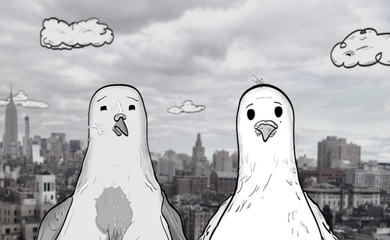With the rise of adult colouring books — colouring books designed for adults, not the other kind of ‘adult’ — has come the rise of animated comedies also targeted at the adult market (think Adult Swim and Bojack Horseman). Now, HBO is rolling out its own entry in the field with Animals, debuting this week, and in an interesting move, it’s hitting streaming before it airs, reflecting a possible shift in the network’s positioning. It may be attempting to appeal to younger audiences, known to prefer streaming, and it also likely wants to be competitive against Netflix, Hulu, and Amazon.
Set in New York, Animals has a ten episode season with a series of connected sketches featuring the animals of the city, in anthropomorphised form. Cats, dogs, carriage horses, and body lice cavort across the screen in a rough, sparse animation style. The scenery is often dark and jagged, reflecting what’s happening on screen, with ad-libbed dialogue recorded before animation to give the show a more spontaneous, organic feel than we usually encounter with animated programming.
What’s happening on screen is definitely macabre, echoing the attitudes that New Yorkers like to pride themselves on. However, it’s hit or miss when it comes to comedy. I could do without the trans jokes, for a start, and while some of the bits are sharp, funny commentaries on the state of modern society, others feel dull and jaded. This kind of humour is very popular among circles in the US, with creators attempting to create a sense of being above it all for smug viewers, and it really just comes off as rather petty.
The bigger phenomenon with Animals is definitely the social trends it speaks to. The United States appears to be experiencing a kind of entertainment regression, with adults turning to colouring books and animated television with a fervor — sales of colouring books specifically targeted at adults grew by an order of magnitude in 2015, and are projected to get even bigger in 2016. This phenomenon is fascinating, and it was predicted by the huge uptick in the sales of young adult novels to adults in the early 2010s, complete with the rise of ‘new adult,’ a genre of books masquerading as being positioned for young adults but really targeted at the 20 and 30-year-olds who are sinking their teeth into young adult fiction. Along the way, the original intended audiences of such media are often losing out, with more and more creators targeting content once aimed at children to adults, and not in a Sesame Street way with wry in-jokes to keep parents entertained while their children follow Big Bird and Cookie Monster.
Labeling these things as ‘childish’ and dismissing their consumers is both insulting and a mistake, but failing to explore why people are turning to media traditionally associated with children is a mistake as well. Something is happening in the US consciousness that’s making people grasp for things that feel comforting and familiar because they grew up with them — cartoons on telly on Saturday mornings, colouring books in class, fiction about youth like them. This isn’t about a stubborn unwillingness to grow up, a Peter Pan attitude sweeping the nation, but something deeper.
It’s not that Americans are in a state of arrested development, but rather that US culture is doing something curious to young adults by making it impossible for them to grow up. The current social and political climate is making it very difficult for people to shake free and build independent lives, and many have more in common with their youth than they do with adulthood. It’s extremely difficult to grow up in a culture that burdens people with severe student debt, joblessness, and a limited safety net — for the privileged it’s possible to leap boldly out into adulthood, but the same doesn’t hold true of the vast majority of Americans.
The generation that grew up reading Harry Potter has come of age, but what it’s finding isn’t a world of freedoms and independence. The drudgery of adult life is a sharp contrast to the fantasies of their childhood, and when it’s paired with measures that seem almost deliberately calculated to keep them down, the retreat to the familiar is perhaps understandable.
Changes in the landscape of the US, where the markers of adulthood were once buying a home and having children, are shifting what it means to be a grownup, and one of the ways that’s manifesting is in media. Thus we see dark, bitter, sardonic cartoons developed by people who are frustrated by the culture they’re living in and the way it freezes the ability to progress, while adults turn to colouring books to address stress created by neoliberalism and capitalist pressures.
Meanwhile, for people who have never really had a chance to grow and change past high school and college thanks to a society that provides few opportunities find more to relate to in teens who are finding themselves than dull literary fiction about the lives of people who seem totally abstract and unrelatable — a 20-year-old reader finds more to identify with in a book about a queer teen than a book about middle aged white people buying a house and bootstrapping the American dream.
Animals fits right in with this larger trend, and one wonders which object of childhood will be appropriated by adults next — after all, grownups are already deeply invested in LEGO projects and action figures, some of which have always been targeted at the adult market. Perhaps it will be Barbie Dream Houses for those who will never own homes, to go along with Nekoatsume (Cat Collector) for people feeding the internet’s cat obsession.

